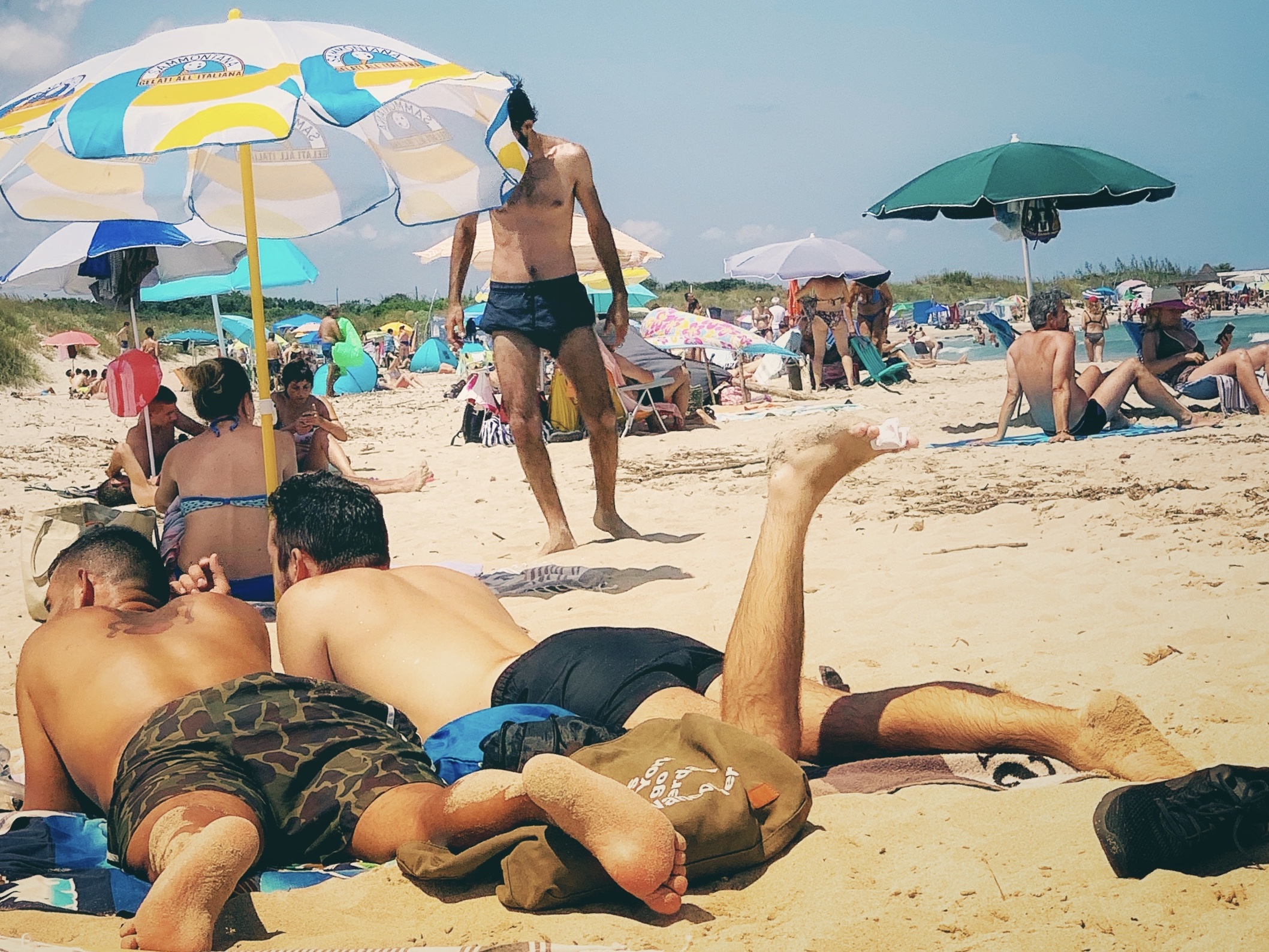DRIVING IN PUGLIA
Do not be put off by stereotypes. Driving in Puglia isn’t difficult. But being aware of the bad habits of some Italian drivers will help you on your way ...
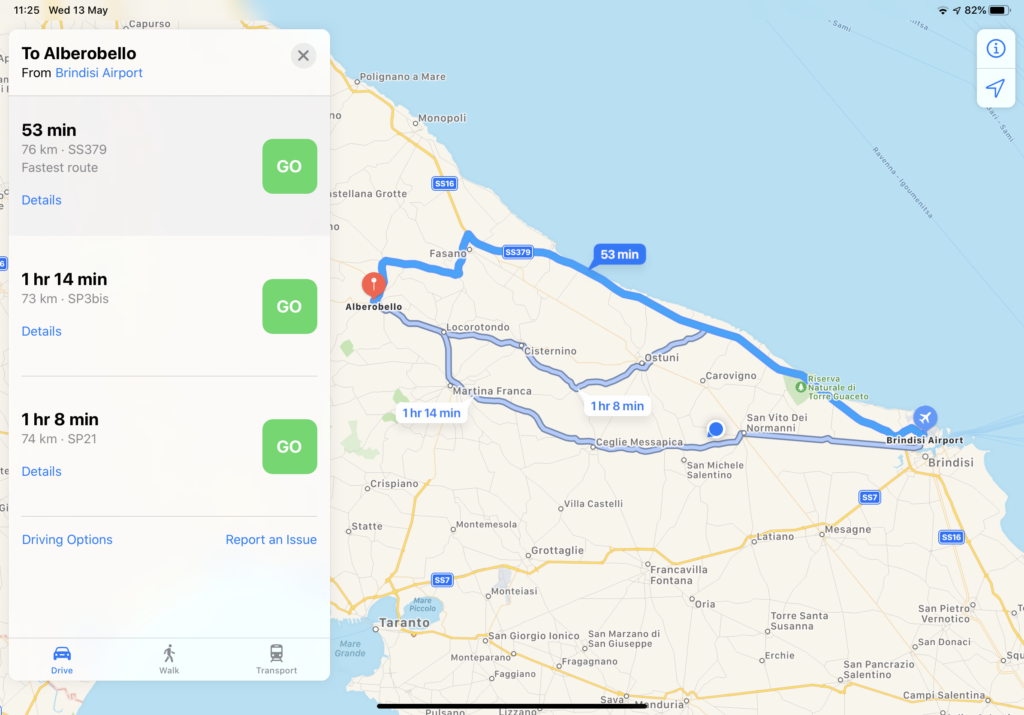
Hiring a car - Bari or Brindisi airport?
If your destination is the Valle d’Itria then distance-wise, either airport might be suitable. Even the fastest route to Alberobello from Bari airport takes longer than the journey from Salento airport.
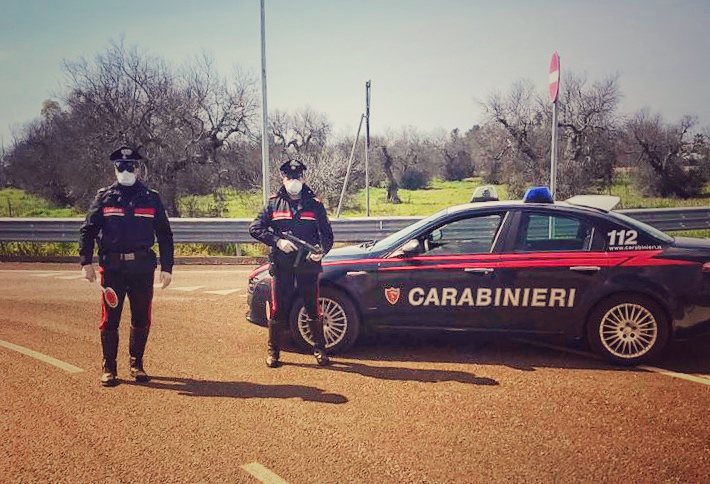
guidare | [gwiˈdare] | to drive
guidare bene/male to drive well/badly
ha mai guidato in Italia? have you ever driven in Italy?
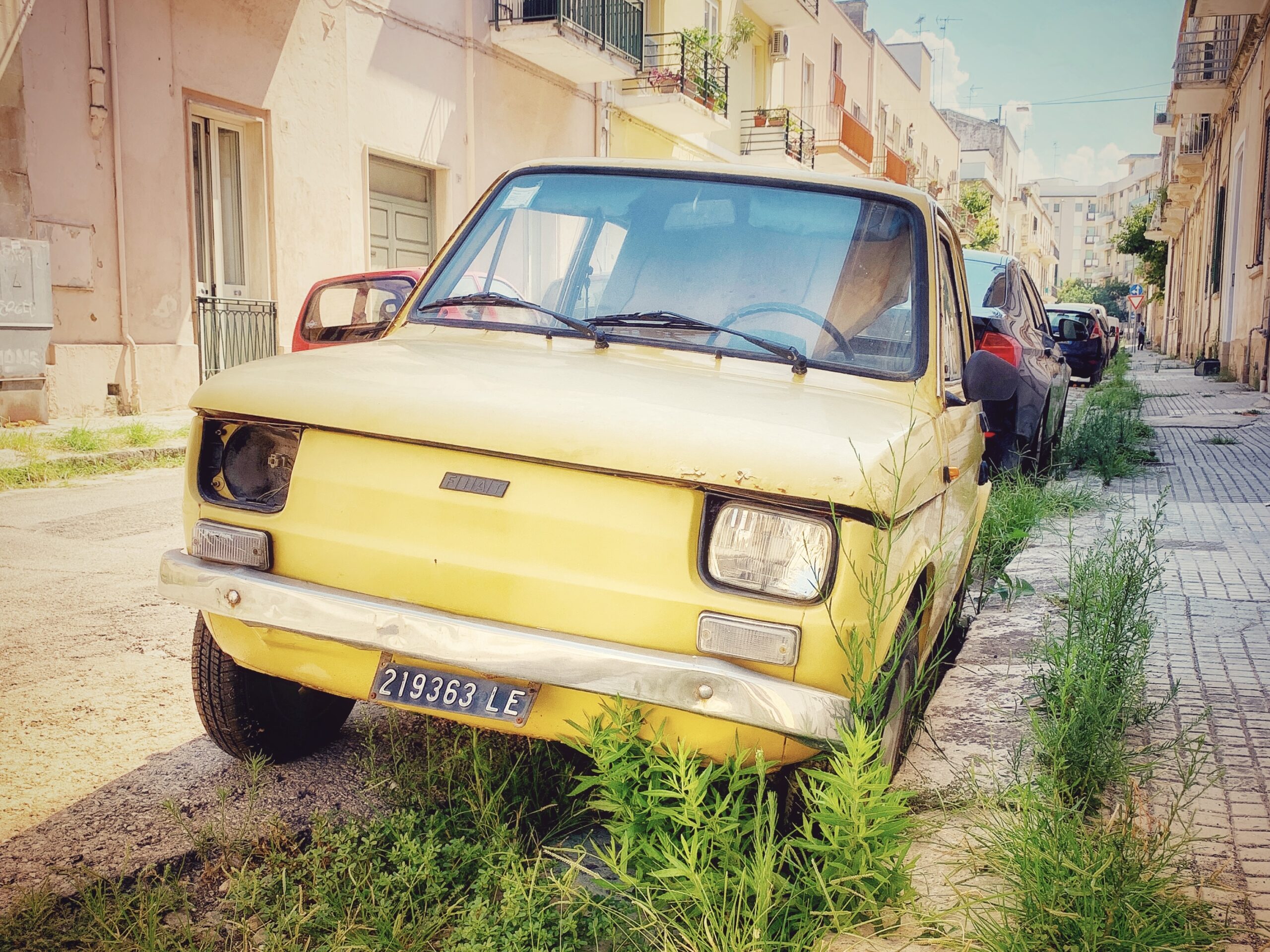
Size matters
When choosing a hire car remember that small is beautiful. Especially when it comes to parking.
Driving in Puglia
The driving in Puglia Podcast and FAQ
Driving a car is the best way to explore our region. Car hire companies operate at both airports. Two things will help avoid making this a complicated experience: understanding a little about the Italian driving culture and staying out of old town historic centres which usually operate a ZTL restricted traffic zone.

The Big Guide to Driving in Puglia
Driving around Puglia is relatively straightforward, and is often the most practical way to get from town to town and to and from the beach.The biggest problem that you are likely to come across driving in towns and cities is finding a parking space.
Keep away from historic old town centres to avoid driving into a ZTL (“Zone a Traffico Limitato”) restricted traffic area. Turn into one, even by mistake and some time later, even 8 - 12 months after your return, the car hire company will forward you the fine for payment. Usually €180 in Puglia, although these can range from €81 to €326 and are often enforced against foreign drivers. In any event driving in the old towns is impractical and challenging.
Most Italian drivers are competent - and fast. Don’t be put off by their aggressive driving. Be confident and you will fit right in.
We do have a highway code, the Codice della Strada. But as with most things in the south of Italy a relaxed approach is often taken. Especially in small towns.
And then there are those bad habits ...
Indicators? What are they for?
If you have learned a little Italian in advance of your holiday then you will know that the personal pronoun (I, you, he, she, we, you, they) is not generally used.
Instead of saying io guido, tu guidi, lui/lei guida - I drive, you drive, he/she drives - we say guido, guidi, guida. We don’t need to say I, you, he/she. The verb ending tells us who we are talking about.
By saying guido, I can only be talking about myself. In this sense saying io guido is unnecessary.
Like the personal pronoun, the use of indicators (turn signals) on vehicles also seems to be unnecessary. The physical act of turning, pulling out to overtake or cutting in front tells us the driver’s intention, making the use of the indicators redundant.
Most Italian drivers do not use their indicators. Whether on the highway, at junctions or that other mystery to Italian drivers - the roundabout.
Beware roundabouts
Approach with caution. Particularly smaller roundabouts (traffic circles) outside larger cities.
Some Italians learned to drive before there were roundabouts in Italy. Many obtained their licence when the rules for priority at roundabouts were different. Others have forgotten the rules or simply don’t pay attention.
As a result, roundabouts sometime seem like a free for all.
The rules are clear. The practice less so ...
Roundabouts are considered as an intersection by the Italian Highway Code. Priority signs or road markings (stop or give way signs) indicate the right of way. If there are no traffic signs or road markings priority to the right applies.
At most roundabouts a give way sign accompanies the roundabout sign. Referred to as “European” roundabouts, priority is given to traffic on the roundabout.
Older “Italian” roundabouts are indicated by the roundabout sign without the accompanying give way or any other priority sign. Traffic on the roundabout must give way to traffic entering the roundabout, slowing down or stopping to allow the arriving motorist to enter. In other words the Highway Code respects the traditional priority at junctions to traffic on the right.
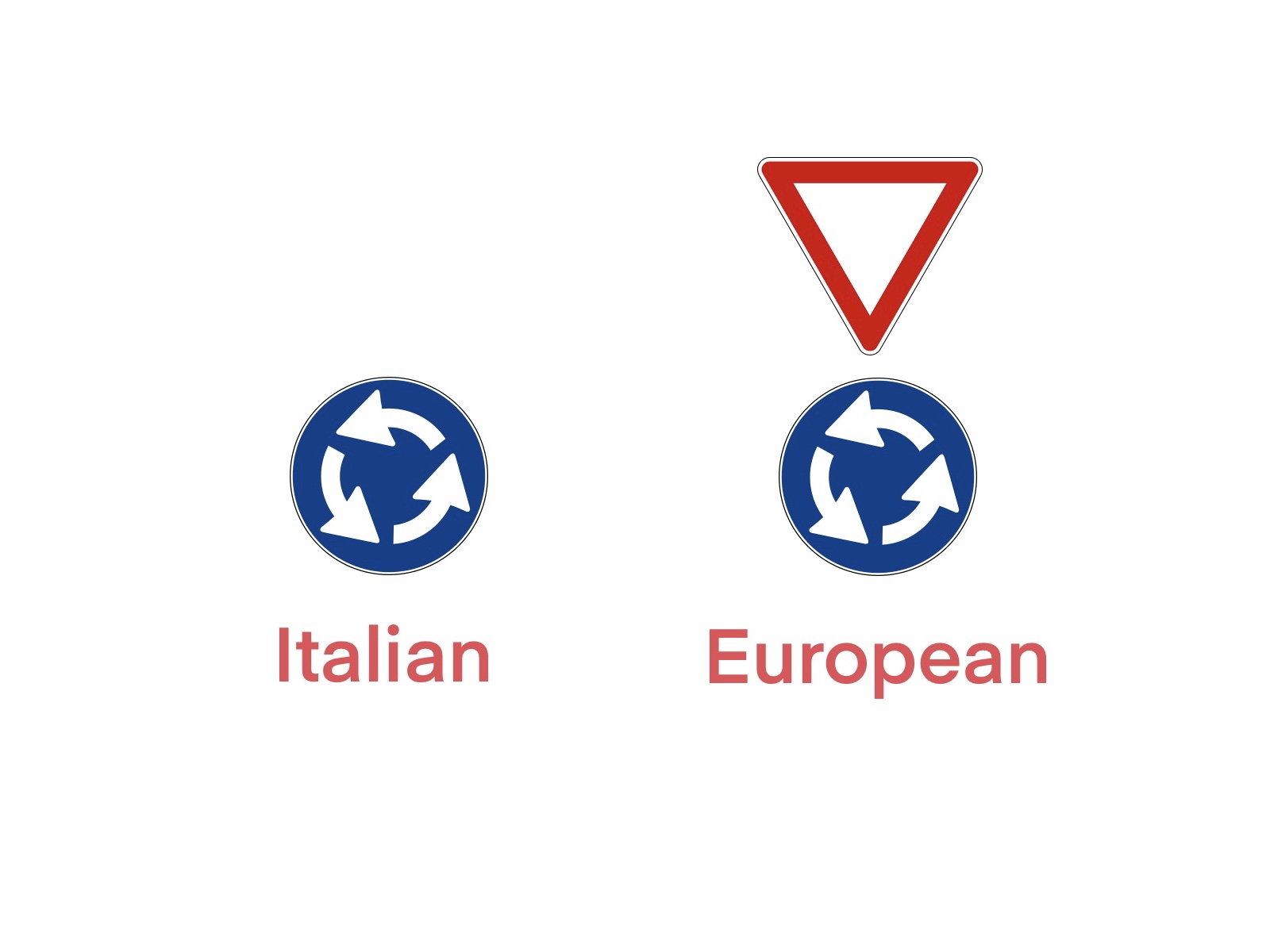
Most roundabouts in Italy adopt the “European” style indicating priority given to vehicles on the roundabout.
Where traffic on the roundabout has priority always be prepared for Italian drivers, especially older ones, believing that they have priority coming onto the roundabout. Keep an eye on the junction ahead. Some drivers will not slow down and will continue to drive onto the roundabout without giving way, without even glancing left.
Since 2011 indicating entry onto and exit from the roundabout has been mandatory. Good practice dictates indicating if going around and exiting left at the roundabout.
In Lecce the series of roundabouts as you enter via the main highway (SS613) from the north - particularly the first two at the bus station and just before the old town - become a free for all during the morning and afternoon/evening peaks. You will need to find the courage and conviction to edge onto them. But don’t get stressed by the impatience of others behind you.
In contrast drivers in Ostuni seem to manage roundabouts much better, with the exception of the busy SS16/via Papa Giovanni XXIII/SP22 roundabout.
Despite the seeming chaos at busy times we have seen very few accidents on roundabouts.
Roundabouts provide Italian drivers with a choice parking spot outside a favourite bar. More considerate road users park on the junction coming off the roundabout.
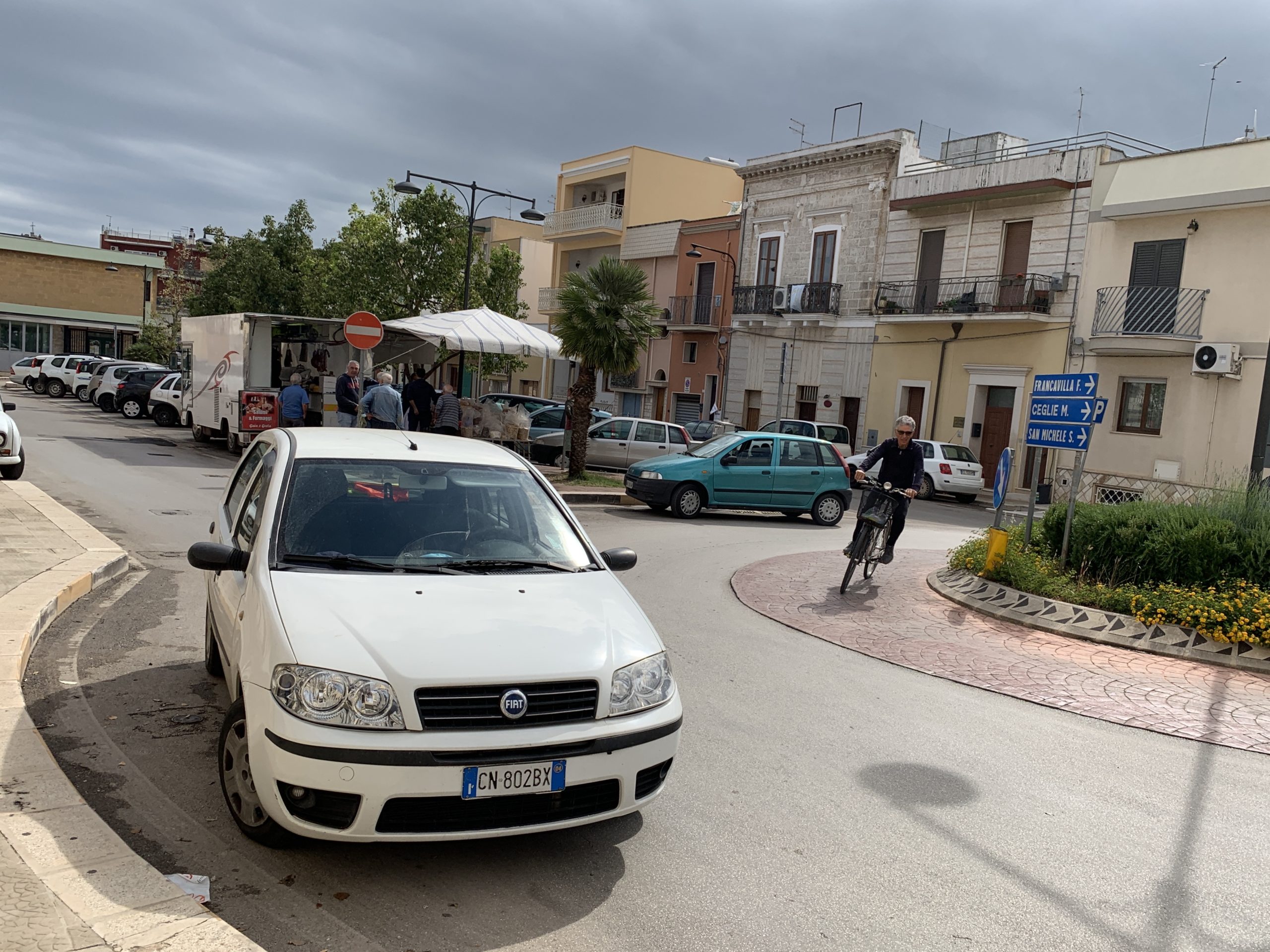
A matter of priority
Motorists at junctions must give way to vehicles coming from the right unless there are signs indicating a different priority.
A stop or precedence sign means you must give way to traffic approaching from both sides.
But stay alert. Many road markings have faded away, so a different priority might not be obvious. In addition many towns have one way systems throughout, with traffic approaching from the left being given priority. It just depends ...
Junctions provide an excellent opportunity for Italian drivers to stop for a chat to passers by. In fact, when driving in towns be prepared for drivers stopping in the middle of the road to chat to friends, to drop off passengers or to get out to buy a pack of cigarettes regardless of any traffic behind.
Give yourself bonus points when the driver in front and the car coming in the opposite direction both stop to chat to each other.
Parking
On street parking is usually available. The challenge is finding a space, and having found one, fitting into it.
Many Italians have become creative when it comes to parking. No need to perfect parallel parking skills when you can just pull nose first into a space, whether the car would otherwise fit into it or not. Who cares if your tail sticks out, another obstacle for road users to negotiate. Corner spots at junctions, pedestrian crossings and roundabouts all provide space that can be utilised by the savvy Italian driver.
When it comes to parking you will understand why small is beautiful when choosing a rental car.
In towns and cities on street parking is usually designated by road surface markings.
Blue lines indicate “pay and display” parking. An accompanying sign gives the relevant details. Machines usually take coins, though some will accept bank cards.
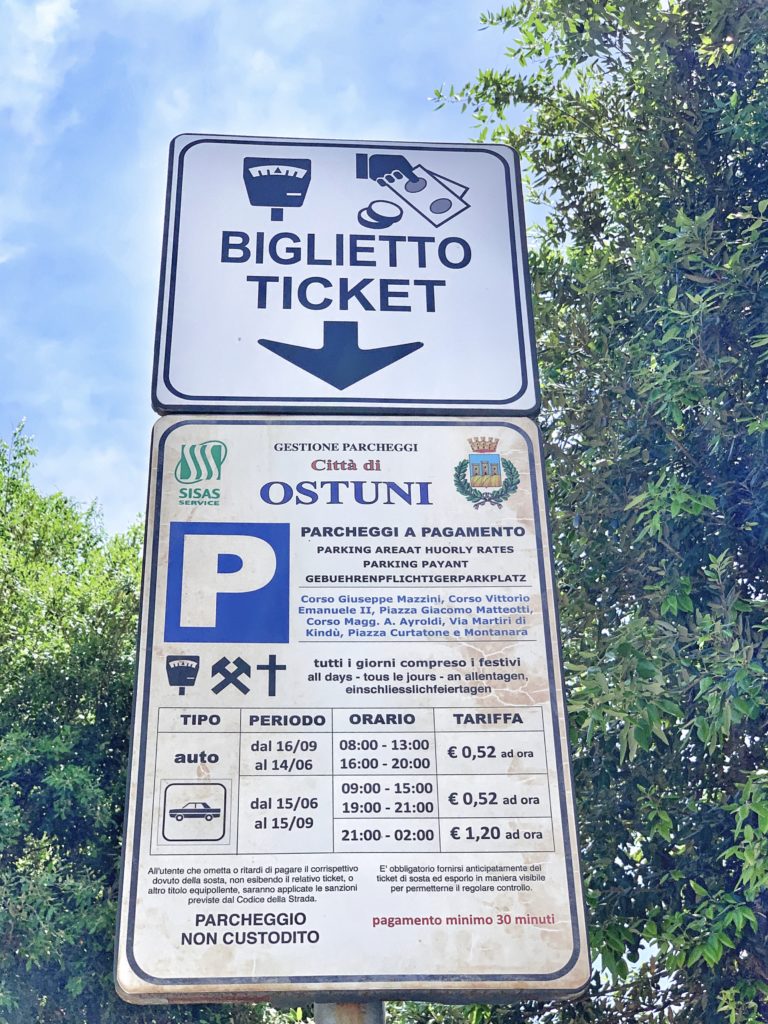
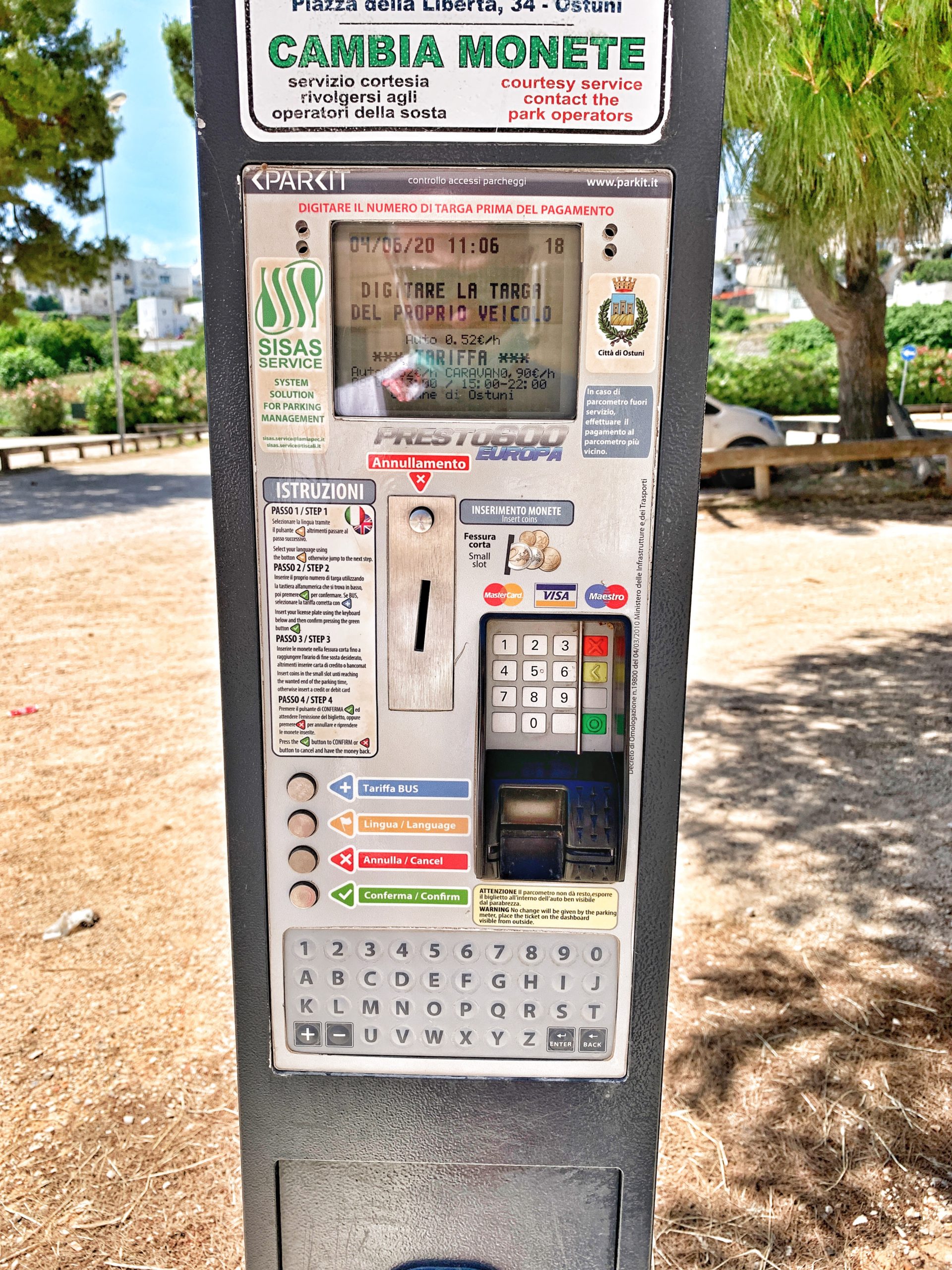
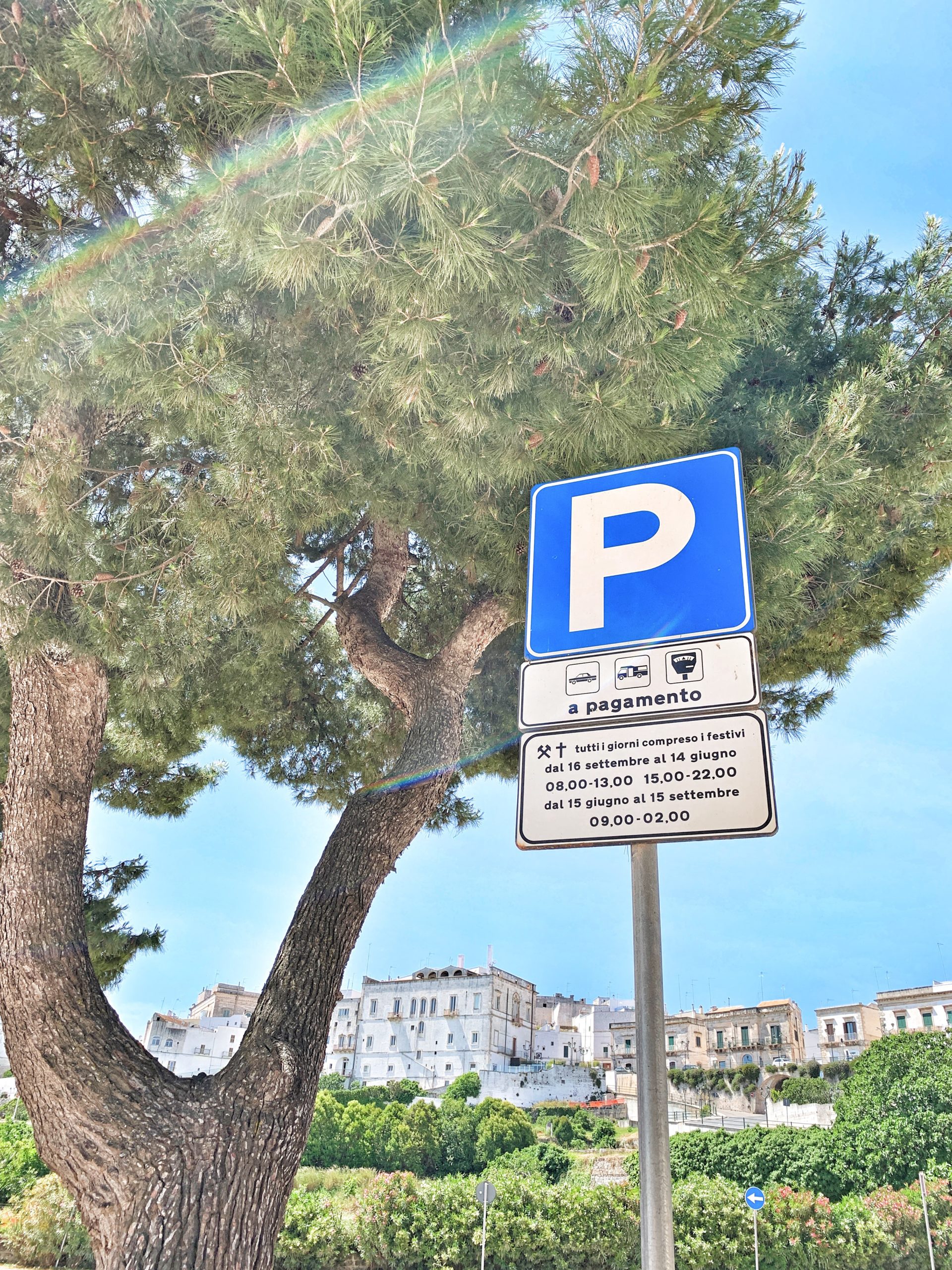
The signs display the times when payment applies, and the rates. Keep an eye on the ticket expiry time when feeding in coins. The machines calculate this for you, and it will jump ahead to take account of free parking times in the afternoon and night.
Sometimes you will need to in put your car’s registration number before paying for your ticket. Look out for the instruction “Digitare la targa del proprio veicolo”. Keep a photo on your smartphone to save you having to go back for this and, if you have queued to pay at the meter, having to join the line again.
Your ticket must be displayed on the dashboard inside the car.
The same regime applies at car parks run by the municipality.
Free Parking
Parking spaces outlined in white are free. Look out for any adjacent sign indicating restrictions (e.g. max. 30 minutes, max. 1 hour). In this case you need to display a parking disc on your dashboard set to time of arrival. You can get these at tobacconists’ or newspaper shops for a few euros. Hire cars usually come with them already attached to the windscreen.
Yellow spaces are reserved for disabled badges, taxis or official vehicles. You might come across green zones where parking is restricted on working days between 08.00-09.30 and 14.30-16.00 hours for deliveries etc..
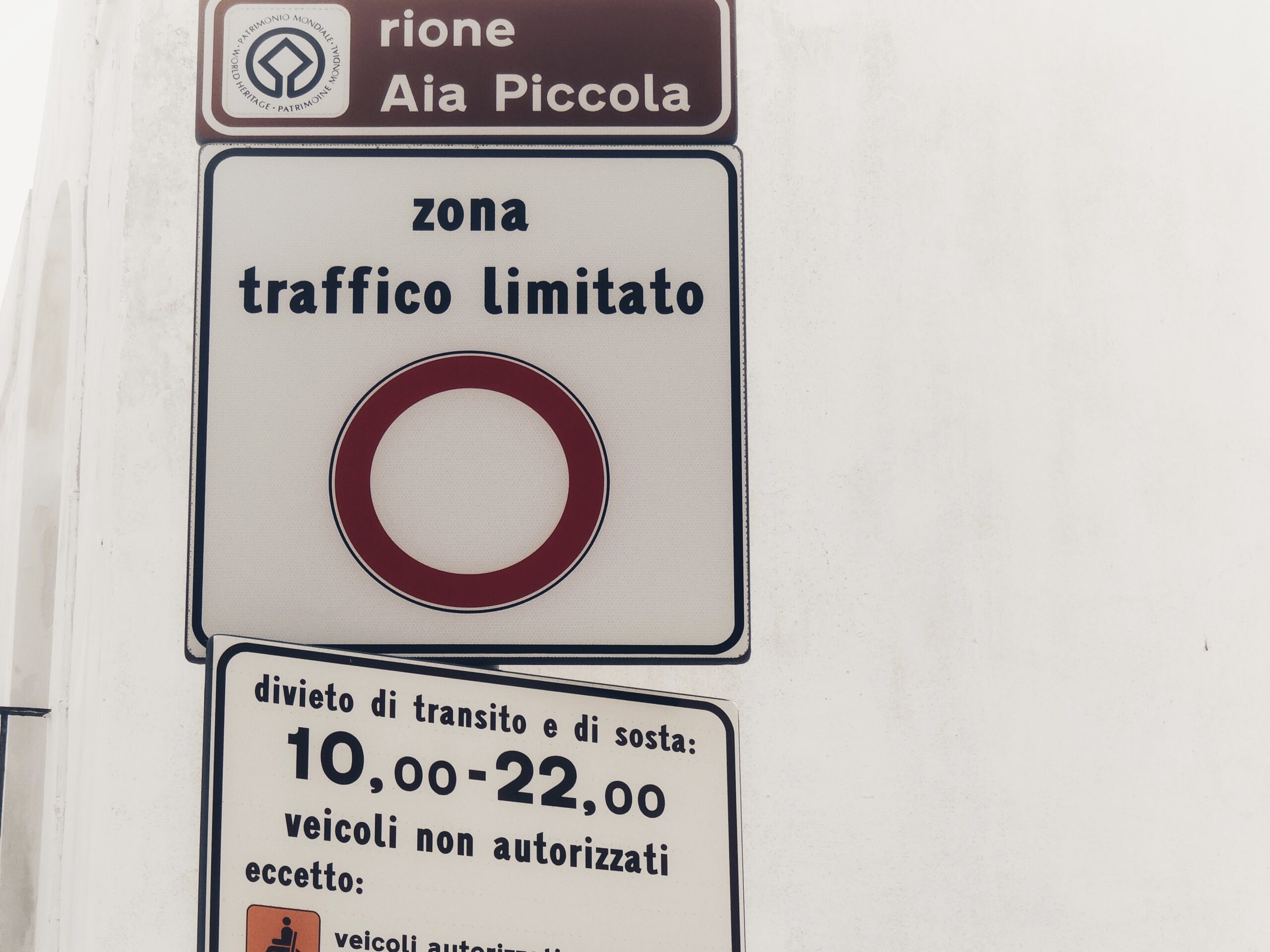
The ZTL
Historic old town centres were not designed for traffic - as will become painfully apparent if you unwittingly navigate into one.
Most include a Zone a Traffico Limitato (ZTL), restricted traffic zones with no thoroughfare for private vehicles, except at certain time of day – usually early morning and late afternoon.
These are indicated by a sign showing a white circle with red borders, stating the hours in which the area is restricted. Driving in an unfamiliar area, while keeping an eye on everything on the road and happening all around, as well the SatNav instructions means that it can be easy to miss these.
That and the added pressure of all those impatient Italian drivers behind you ...
Anytime a vehicle enters or exits a ZTL cameras take a picture of the license plate. The photo is automatically sent to the Municipal Police computer. If the license plate is not registered a fine will automatically be issued, and forwarded by the car hire company.
Fill her up
Most stations have self-service and, at a cost of about €0,08 more per litre, attendant service.
For self service you usually have to pay in advance, and select the pump. Be sure to have notes. VISA debit/credit cards never seem to work. Even our Italian bank and credit cards prove challenging, though usually we have more luck with MasterCard than VISA.
There is no change given - if you select €50 of fuel and your tank fills up after €30, you will have made the day of the driver behind you. Be sure to have a few twenties and tens. You can always select another €20 of fuel after the first.
A number of stations on the autostrada and main highway do have stations where you fill up and pay after. Our cards seem to work better there, but these are fewer.
Take care to select the correct pump; a number of times we’ve paid for the pump on the opposite side and had to stretch the hose over. Even after watching the “idiot” in front of us do the exact same thing ...
UK visitors - diesel is much cheaper in Italy than petrol - benzina.
The least expensive stations that we have found are the Tamoil ones and the Ipercoop station at the Le Colonne shopping mall just outside Brindisi.
SPEED LIMITS
Unless a lower limit is specified:
In cities and towns (urban areas - beware, these often extend to the stretch of highway passing around them so look out for signs indicating lowered speed limits, even on the highways) the limit is 50 kmh.
On other roads, maximum speeds are: 90 kmh on local roads; 110 kmh on non-major highways outside of major urban areas and 130 kmh is the speed limit on highways.
Tailgating and overtaking
Italian drivers will come up right up behind you when they want to pass. Tailgating until the opportunity to pass comes is common on the highway.
Instead of waiting for approaching overtaking traffic to pass safely by, Italian drivers will often pull out in front (without indicating of course) expecting / forcing vehicles in the overtaking lane to slow down. Just as abruptly they will then cut in front of the car they have overtaken. Etc., etc..
Don’t worry if you are flashed at night when being overtaken. Many drivers do this to alert you to their presence. It’s not because your rear lights are not working (something else that doesn’t seem to cause a problem for drivers in the south).
If you are flashed by oncoming traffic during the day this is often to alert you to the presence of police further down the road. A mobile speed camera or a random police stop to check documents.
Highway -vs- local routes
Driving through the countryside is stunning, especially through the Valle d’Itria, or our absolutely favourite drive in Puglia - the coastal road from Santa Cesarea Terme to Santa Maria di Leuca.
As you venture into the countryside many roads are single lane, even on the main routes. Some are single track.
Slow moving agricultural traffic are common as soon as you are off the highway. Getting stuck behind a tractor or ape can be frustrating, especially with a long line of traffic already behind them on a road peppered with curves and bends. Even more so when climbing uphill. Monopoli to Alberobello anyone?
The Italian road classification system has:
- strade communali
- strade provinciali
- strade regionali
- strade statali
- autostrade
The volume of traffic on the strade statali (SS) varies from place to place. Some are the busiest roads, but they can be very quiet and scenic, especially in the more remote parts of Puglia.
The SS16 is the main highway around Bari, but then diverts off of the highway to Fasano, Ostuni and San Vito dei Normanni, before joining the highway again at Brindisi.
There are also some strade statali where a new faster road (a superstrada or strada scorrevole) has been built alongside it, leaving the old road still with the same classification. (Strade regionali by the way are basically strada statali where responsibility for maintenance has been transferred to the regional government).
Again this happens with the SS16. It separates from the highway heading south around Brindisi. The highway becomes the SS379 and the SS16 runs in parallel to the west of the highway.
The strade provinciale (SP) and strade communale are usually the best bet. Although bear in mind that a strada provinciale between two towns is still likely to be busy with local traffic.
The SS16 Highway | SS379 | SS613
The main highway linking Bari, Brindisi, Lecce and Otranto generally follows the Adriatic coast.
Around Bari it’s designated the SS16 ringroad (tangenziale). With freeway features it has separate carriageways opening from two to three lanes around junction 4 before switching back to two around junction 14.
There are two tricky sections to watch out for.
The very first section of highway after coming out of Bari airport heading south curving around Palese has little if any (hard) shoulder. Acoustic screens rise up to shield adjacent residential properties. The guardrail barrier seems to be squeezed into the space between carriageways. This makes for a tight curve with fast moving traffic - especially on the carriageway heading towards the airport where the traffic has just switched from three into two lanes.
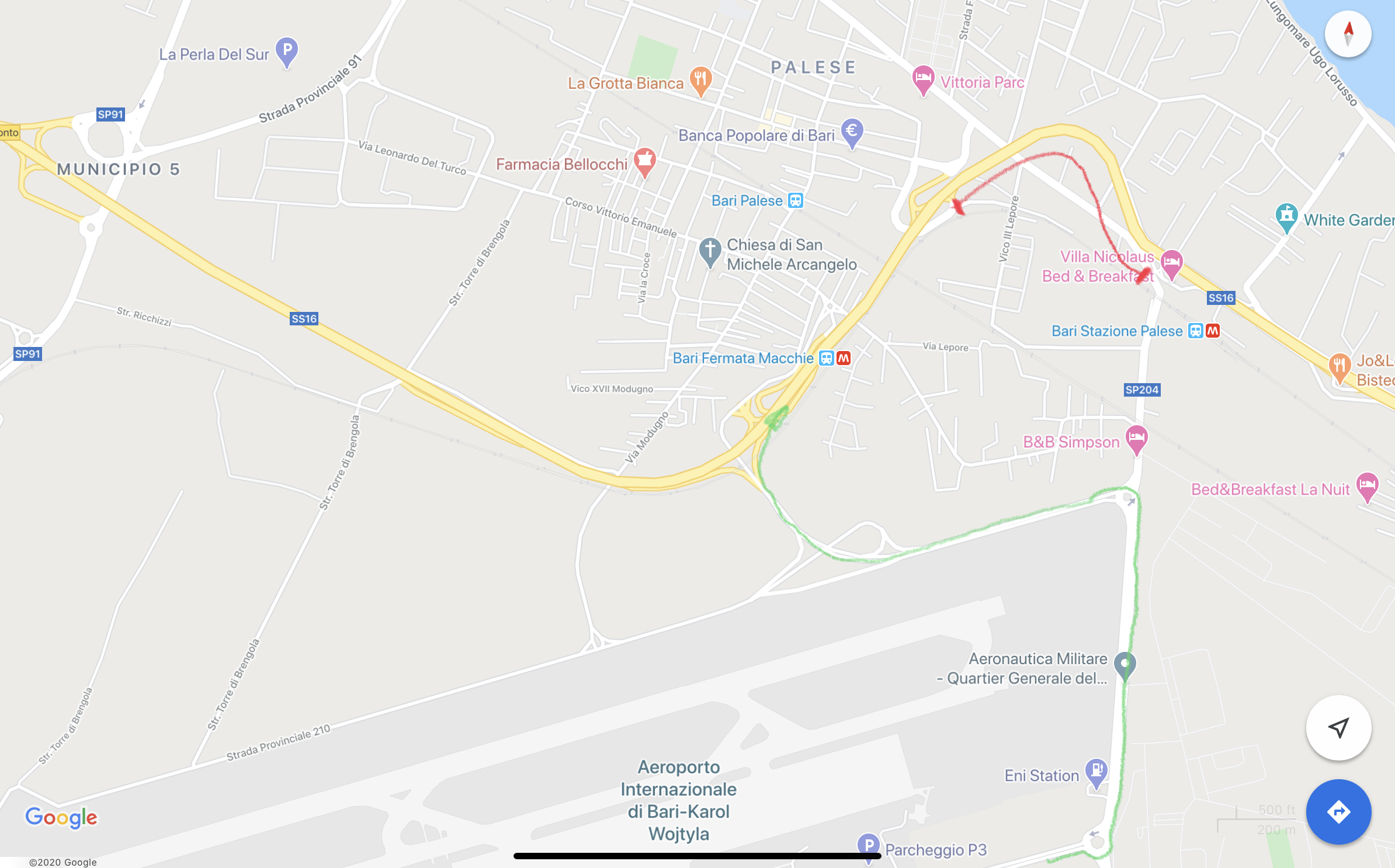
Between junctions 13 and 14 recent road realignment works have left a couple of really bad curves. Be especially careful of vehicles driving too fast and cutting across lanes to take the bend.
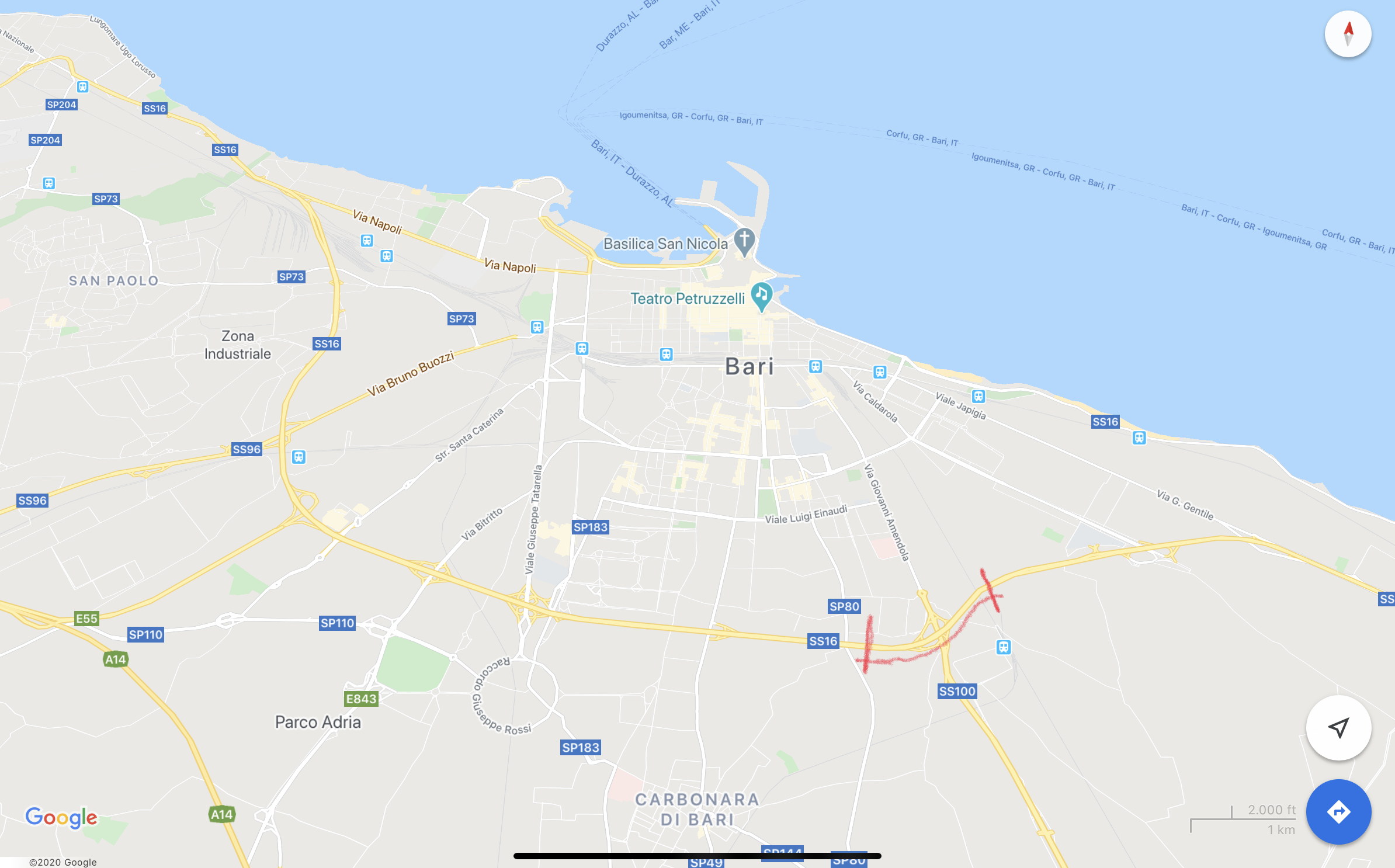
Otherwise it is relatively unproblematic. Traffic usually flows freely except around Bari at peak times. There is heavier traffic coming into /out of and around Lecce as also (but less so) around Brindisi which might also cause some congestion at peak.
The designation of the highway changes from the SS16 to the SS379 just after Monopoli near Fasano. For a small section of highway around Brindisi it becomes the SS16 again until it the SS16 detaches and the highway continues as the SS613 Brindisi-Lecce road. It continues south of Lecce as the SS16 to Otranto.
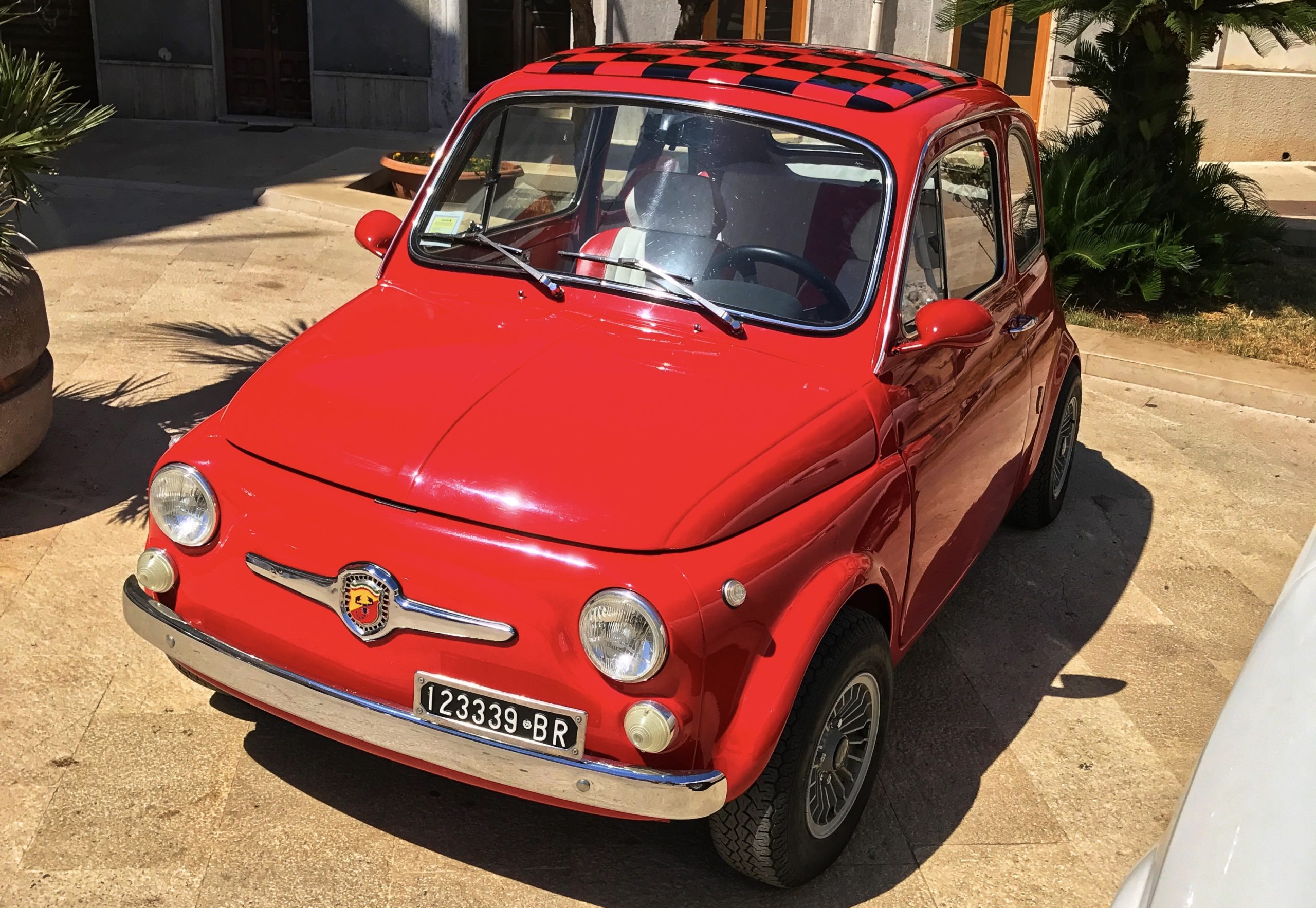
TOLL ROADS
Toll booths are located on the autostrade (highway) entrance. The autostrade are indicated by the letter A and a number, for example A1, and a green octagonal sign.
A ticket is issued by the auto machine. Do not use the TELEPASS lane unless you are a telepass customer.
Keep the ticket issued - you need it to exit, which is when you pay at the toll booths located at the exit. If you are not able to show the ticket at the exit you will be charged the maximum charge. When you exit the toll road, be ready to go into the correct lane. This will depend on your method of payment.
The white lane with the coins symbol is for self service cash payment.
The blue lane with the cards symbol is for payment using credit card, ATM or bancomat card.
The yellow TELEPASS lane is for cars and lorries fitted with a electronic scanner that automatically calculates the toll and debits the users’ account.
The toll you pay is calculated based on a variety of factors: distance, vehicle type and road features (plain or mountain). You will find a tool for calculating your journey here.
Trunk, regional and provincial roads do not require any fee to be paid (SS, SR, SP - indicated by a blue rectangular sign).
If you are using GPS / SatNav - your settings might default to exclude pay/toll roads, which might account for why the journey time is showing 2 or 3 times more than you expect. Double check this just in case.
Want some more?
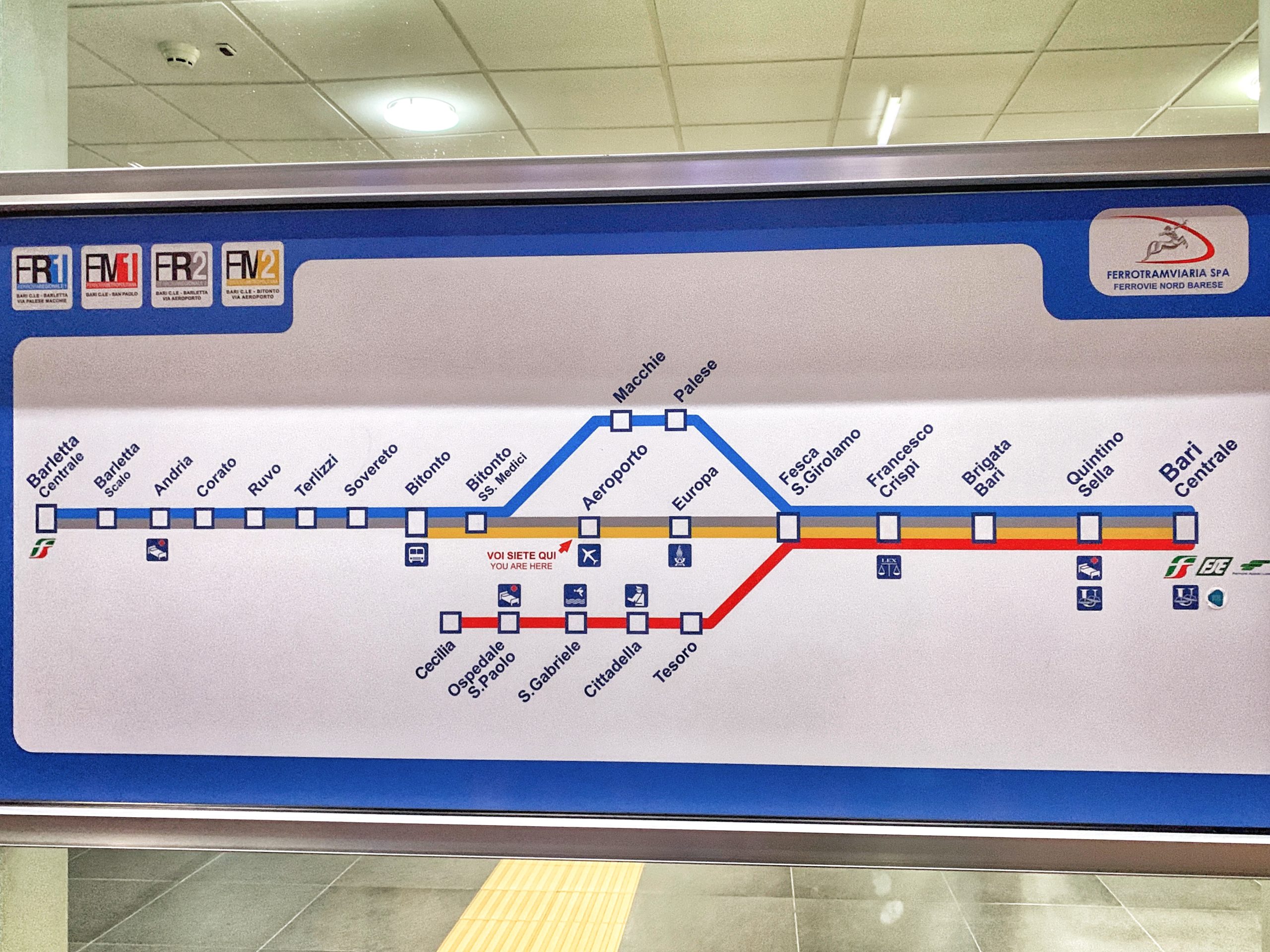
Voi siete qui - arriving at Bari airport
When you come out of the arrivals hall into Bari’s main airport terminal, on your left side at the end of the building is the exit that takes you to the railway station (clearly indicated over the door).
There you can take the train into Bari and for onward connections.
Above | train connections to the airport. There are two lines so the trains are frequent.
Below | main railway network serving Puglia.
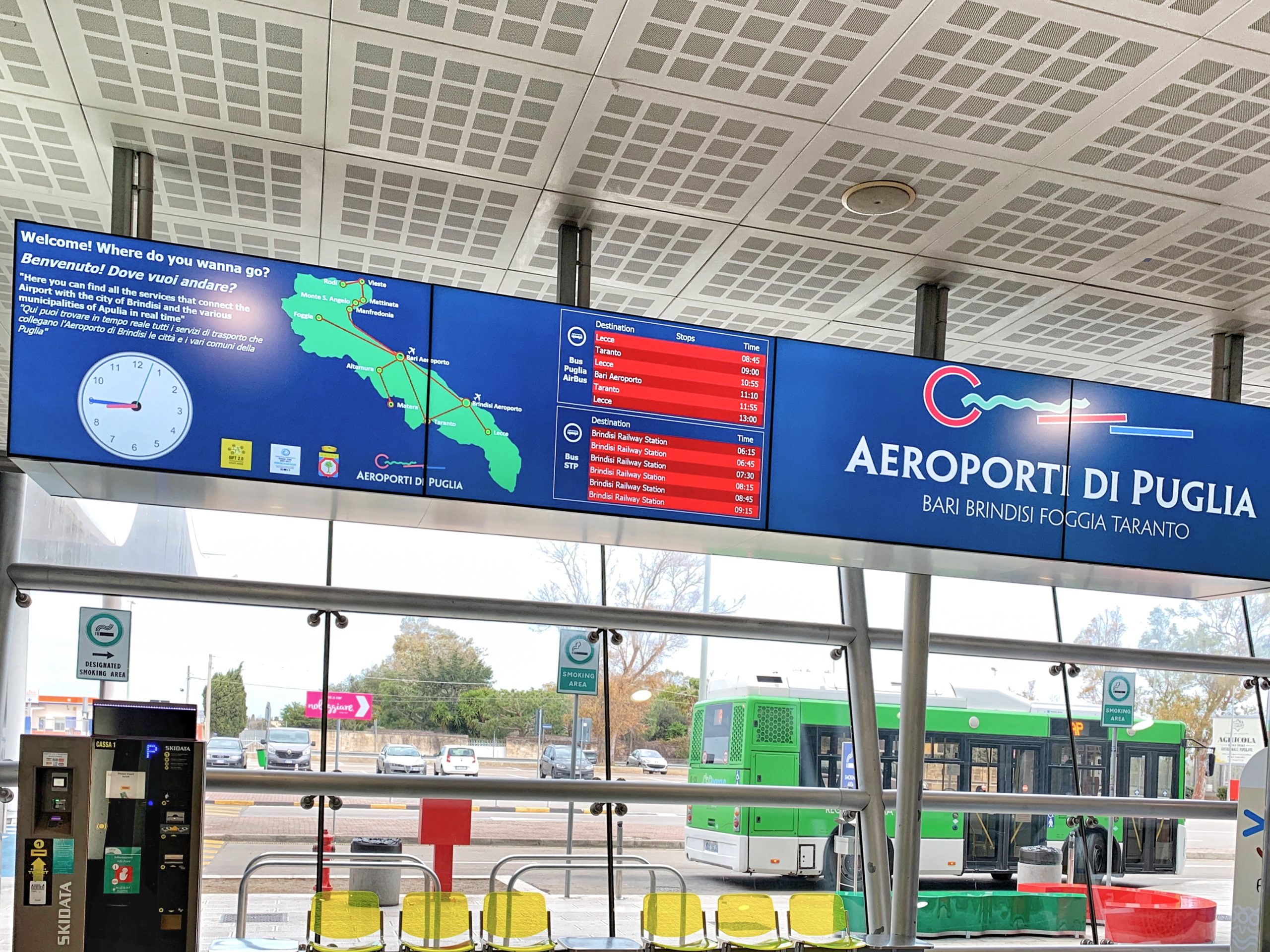
Arriving at Salento (Brindisi) airport
Step out of the arrivals hall into the main terminal building. Immediately ahead is the bus stop for the bus connection into Brindisi and the train station, for onward connections.
There is no train station at the airport; take the bus (€1 in advance inside the airport, €1,50 on board - turn right as you exit the terminal building), or a taxi (turn left). The taxi costs a €20 flat fee for anywhere within the metropolitan area of Brindisi.
Above | bus connection into Brindisi and the train station.
Below | bus timetable and route.
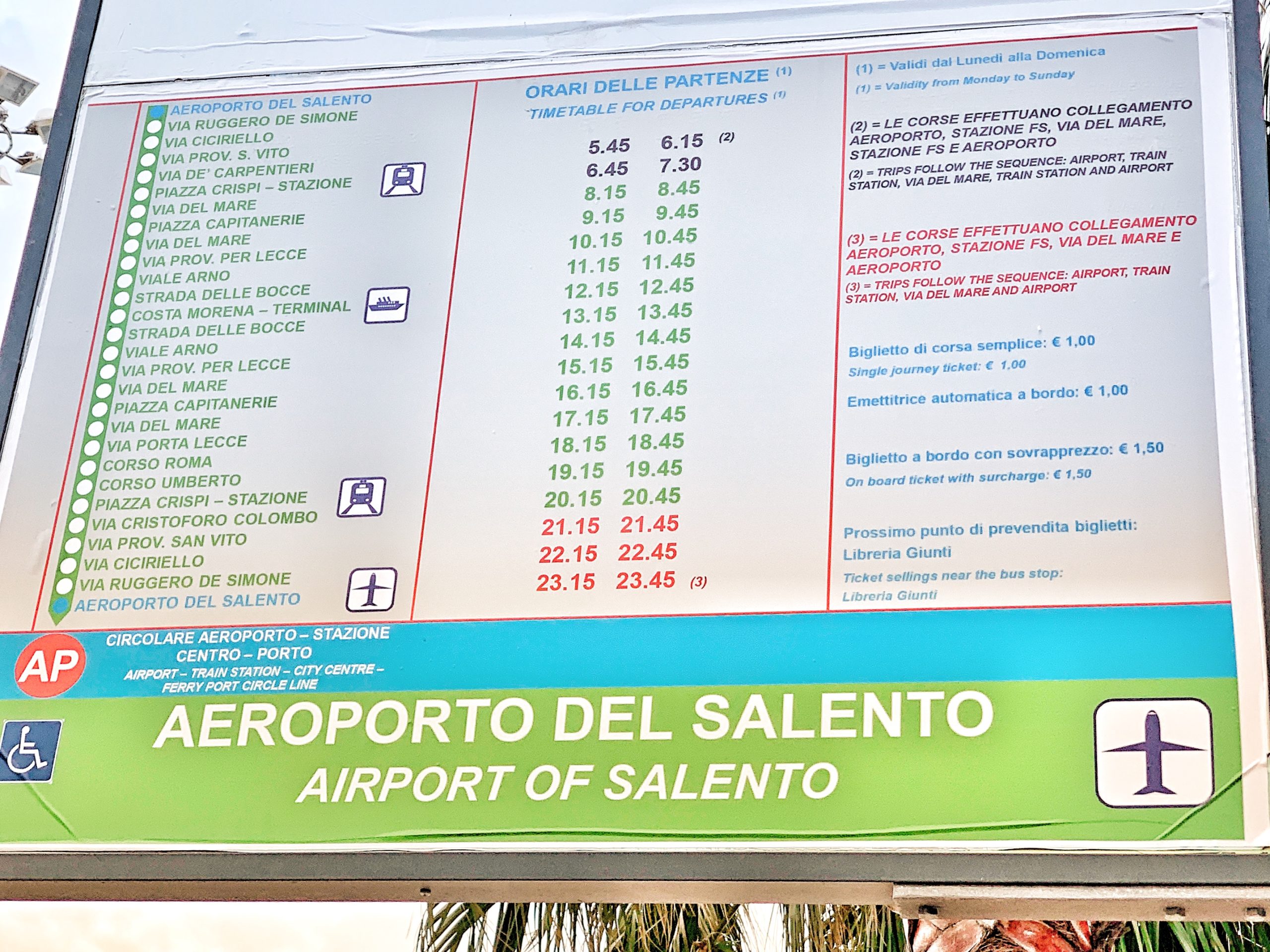

Because you’re worth it
However you get here, isn’t it worth it?
Whether you have come for the great food, the fantastic beaches, or just a relaxing holiday under our blue skies that melt into the sea, there is plenty to do and see.
Discover the beaches that others visitors haven’t yet discovered and the lesser known towns that more than match Monopoli and Polignano a Mare to make your holiday feel even more exclusive.
